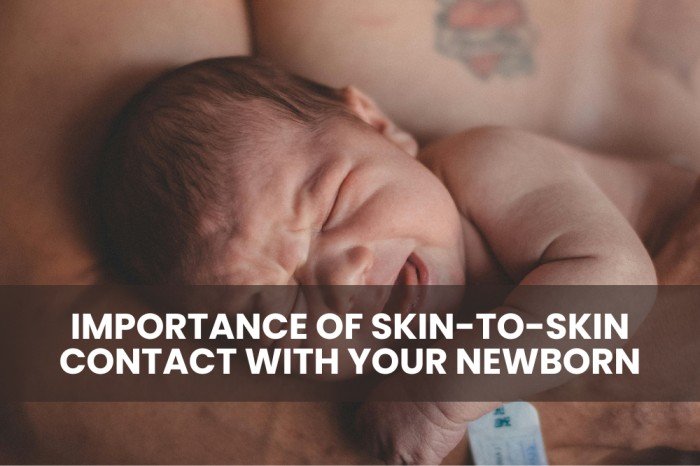From the very beginning of life, babies naturally seek warmth and comfort. In the womb, a mother’s body provides everything babies need to feel safe and secure, from warmth and nutrition to oxygen and protection. Once they are born, the steady warmth is suddenly lost, leaving them exposed to a new and unfamiliar environment.
This is where skin-to-skin contact plays a major role. Skin-to-skin contact, as the title says, involves the practice of placing the baby on the mother’s bare chest immediately after the birth. Termed “kangaroo care,” this simple but multi-beneficial process helps in the baby’s physical health, emotional security, and developmental growth; meanwhile, it also assists in the mother’s recovery and bonding.
An Overview of Skin-to-Skin Contact
Studies show that practicing skin-to-skin contact within the first 60 minutes of birth provides both long-term and short-term benefits for both the baby and the mother, while nurturing the bond between them. As the mother engages with her baby, her body will generate maternal hormones. Following this, the baby’s instincts come alive, guiding the baby through a natural process of becoming familiar with their mother’s warmth and breast. If this process continues uninterrupted, the babies will successfully achieve their first breastfeed on their own. Moreover, this familiarization will help babies achieve self-attachment without issues, eliminating feeding problems down the line.
Most of the healthy babies will follow this process, as long as they are not interrupted. Interrupting the process or hurrying the newborn through this can cause feeding complications in the long run. Also note that if the mother is given analgesia during labor, the baby may remain drowsy for some time after birth, so this process may take more time.
Organizations such as the World Health Organization (WHO) and UNICEF recommend this practice as a standard part of newborn care. While considered particularly important during the first 60–90 minutes of birth, skin-to-skin practice is also advised beyond the delivery room, be it during breastfeeding sessions, after baths, or as part of daily bonding time.
Benefits of Skin-to-Skin Contact for Babies
As newborn babies are highly sensitive and vulnerable during the early days of life, skin-to-skin contact provides an immediate sense of comfort and security. The major benefits of skin-to-skin contact include:
Stabilization of Vitals: A newborn can find it quite challenging to adjust to life outside their mother’s womb. Research shows that skin-to-skin contact brings about an immediate stabilizing effect on the baby’s vital functions, such as regular breathing and steadier heart rates. This has been observed both in the case of healthy babies as well as premature babies. It is widely believed that the mother’s heartbeat and breathing act as natural regulators that support the baby’s transition to breathing independently.
Temperature Regulation to Stay Warm: The risk of hypothermia is highest immediately after delivery because newborn babies lose body heat rapidly. Babies have little to no fat insulation and cannot shiver to keep themselves warm. In fact, skin-to-skin contact with the mother is considered the most effective way to keep a baby warm and works even better than artificial warmers. While the father’s body heat also helps via skin-to-skin contact, it cannot work with the same intensity as the mother’s due to the hormonal and physiological changes that prepare the mother’s body to protect and nurture her newborn.
Adaptation to Early Breastfeeding: As we have observed above, skin-to-skin contact right after the birth plays an instrumental role in the baby’s breastfeeding success. The “breast crawl” phenomenon helps the baby to crawl and attach to the breast independently. If left to occur naturally without any disruptions, the baby will face fewer difficulties in feeding. Moreover, skin-to-skin contact releases the ‘love hormone’ – oxytocin in the mother’s body. This hormone helps in stimulating milk production and in establishing healthy and uninterrupted breastfeeding.
Build the Babies’ Immunity: Newborn babies are highly prone to infections due to their immature immune systems. The initial skin-to-skin contact right after birth helps babies attain good and beneficial bacteria from the mother’s skin. The good bacteria protect the baby from harmful germs and keep them safe by colonizing the baby’s skin and gut. Additionally, the mother’s milk provides the essential antibodies and nurtures the good bacteria to keep the baby protected and healthy.
Calmer Babies: Separation of the baby from the mother’s womb can often trigger stress in the baby and make them cry. Skin-to-skin contact can bring about an instant change by reducing the baby’s stress and making them calmer. This is a visible and noticeable sign of the comfort and security that babies feel when held close. This also allows the baby to keep their blood sugar stable and contributes to better overall growth.
While the above are some of the major benefits of skin-to-skin contact, parents who follow this strictly are shown to have stronger bonds with their children over the years, with reduced anxiety in the mother and even better thinking and reasoning abilities in the child.
Get Expert Care at STEPS Clinic Dubai
At STEPS Clinic, Dubai, we understand and believe in the criticality of skin-to-skin contact for the baby within the first few hours of birth. Our pediatrician encourages this natural practice of skin-to-skin contact between the baby with the mother, rather than relying on artificial methods for warmth and comfort.
Our doctors’ support ensures that both the mother and newborn stay healthy and experience a safe and gentle beginning of their life together. Book an appointment or visit STEPS Clinic to get expert care and advice for both mother and baby from experienced gynaecologist and pediatric doctors.

